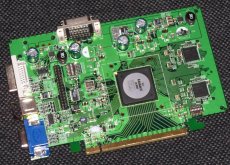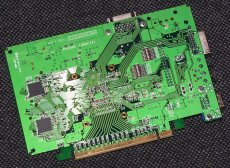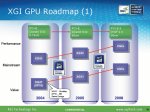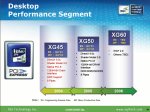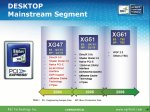XGI
Following the poor press XGI received for their initial attempt at the high end gaming market with the Volari V8 Duo product, XGI have seemingly climbed into their shell but in doing so have been refocusing their business for the time being. The enthusiast market demands a product to be virtually flawless when they are spending upwards of $400 and as such any issue tends to get amplified, with a company starting afresh with new hardware and new drivers their they were bound to run into some issues with the Duo line and inevitably they met with many. Although the Duo experience has giving XGI a foot in the door with game developers, and a platform for building on their game support, XGI are presently working to build more stable foundations at the bottom end of the market in the interim, and provide low cost, entry level solutions, where they can gain more experience and gradually build up both their architectural platform and driver support. From what we hear their strategy is beginning to gain a little traction and boards are beginning to move through the channel – while nowhere near the levels of NVIDIA or ATI, from what we understand it is somewhat better than S3.
In keeping with this new strategy XGI are in the bring-up process of their first, full PCI Express graphics chip, the 130nm based XG47. The chip itself is fairly recent and they brought a board to CeBit that they have been running tests on. XGI are currently still working on the drivers for full 3D support however 2D and video decoding operations were running on the board already.
XG47 is a DirectX Shader Model 2.0 part with a 64-bit DDR interface, aimed at the low end and notebooks – as with S3, for notebook platforms XGI are currently building MXM modules for this. According to the specifications we’ve seen the composition of the chip is a little interesting with two pixel pipelines each with 8 texel samples (2 texture samplers), 4 Pixel Shaders and 8 depth/stencil outputs. Although this support Shader Model 2.0, not 3.0, the peripheral support for DirectX9 looks reasonably robust, on the face of it, with MET/MRT, up to FP32 texture formats, non power of 2 textures and 8Kx8K texture size support. Unlike XGI’s previous chip that relied on an external chip for numerous display options, the XG47 has more robust display support integrated into the chip, such as LVDS, TMDS, TV Out and a 420MHz RAMDAC. Like ATI's "HyperMemory" and NVIDIA's "TurboCache" solutions, XG47 can also render to system RAM via the PCI Express bus, but unlike either NVIDIA or ATI's solutions XGI are suggesting that they will offer configurations that go down to zero local memory at all.
XGI's product after XG47 will be another 130nm based part, the XG45. XG45's performance is aimed more towards ATI's X700 series and NVIDIA's 6600's and will feature Shader Model 3.0 capabilities. The memory bus is somewhat unusual in that it can be utilised in 96-bit, 128-bit or 192-bit widths. Supporting these unusual bus widths also gives rise to some local memory configurations that haven't been seen before, such as 96MB and 192MB configurations. Like XG47 this will be aimed at application in notebooks, again with MXM support, and desktops - XGI are aiming for high end speeds of 450MHz core and memory clock speeds in the top end configurations.
Further beyond XG45 XGI's roadmap currently includes XG50 and XG51, both of which are 90nm with Shader 3.0 capabilities, with the XG50 looking to be a faster variant of XG45 and XG51 having half the pipeline of XG50. The XG6x series will follow up in 2006 with WFG2.0 capabilities.
Our thanks to Hexus for the accomodation at CeBit. Hexus's CeBit coverage can be found here.
- Please feel free to comment on this article here.

